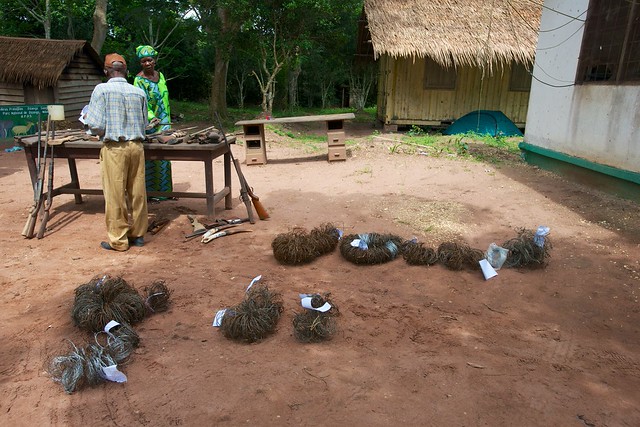NOTE (May 11, 2013): Please see my post about the elephant massacre that occurred at Dzanga Bai on May 7 and the video I made (before the slaughter happened) about the plight of forest elephants. I have also been posting a photo a day for every carcass found so far: Day 1 (the same post as the first link) | Day 2 | Day 3 | Day 4 | Day 5
__________________________________________
Earlier this month, I got to visit Dzanga Bai on a free afternoon. Halfway through the 30-minute trek on centuries-old elephant trails and through thigh-deep rivers, it started raining. Hard. I had never been outside in such heavy rain before. In fact, by the end of it, my clothes were much cleaner than when I started. I had been told it was beautiful, but when I got there I found myself in awe.

The rain made it even more beautiful in a dreamy, surreal way; tourists seldom get to see the clearing (“bai” means clearing) in this kind of weather. In July the Sangha Tri-National Protected Area, which includes the Dzanga-Sangha Forest, became a UNESCO World Heritage Site. The site spans an area covering national parks in three different countries but I think that Dzanga Bai, a relatively small place, deserves to be a Site in its own right. Though famed for the large congregations of elephants that gather there, I was blown away by its beauty before I had spotted a single elephant.

As the rain cleared, elephants and buffalo slowly emerged from the mist. Though officially only a sub-species of the African Elephant (for unnamed “political” reasons), these Forest Elephants ones are in fact, biologically, entirely different from the Savannah Elephants.

Elephants are attracted to this naturally occurring clearing for its mineral-rich mud. Here you can see them digging their trunks in as deep as they can to drink up the salty goodness.

The perfectly lovely raised mirador from which you can observe the sights. If you come visit me, I can even take you camping here for the night…

That day, there were about forty elephants. On a good day, there can be up to 120!

I do apologize if the photos seem repetitive, but I have to settle for quantity and not quality in trying to show you the grandeur of this place.

The elephants mingling with other subjects of the animal kingdom.

The elephants love the little lakes that form after a heavy rain.

On the mirador we met Andrea Turkalo (whose back is to me in the above photo), yet another legend of the area. She has lived here for almost thirty years, spending virtually every day studying the elephants. Some journalists have dubbed her “The Elephant Whisperer”, which seems especially uncreative seeing how she lives only a few kilometers away from Angelique, “The Gorilla Whisperer”.

Dzanga Bai and its inhabitants have such a sacred air to them that it’s almost hard to believe that they are under constant threat from poachers. Almost. Here you can see some snares found in the forest (though these are probably not designed to harm elephants). Bushmeat (some of which is legal) is a popular source of protein for locals here, but the illegal ivory trade is for the big-time poachers. At Dzanga Bai elephant numbers are highest in the middle of night, due in large part to pressure from poachers. Gorillas are not immune to these threats either.

Some confiscated locally-made guns, as dangerous for its human owners as its animal targets due to their tendency to explode at random.

I am very relieved that people like Andrea Turkalo and the local WWF staff are helping to make sure that this place continues to exist, in all its its biodiverse glory. For all the times I’ve been seduced by some touristy site’s “World Heritage” claim, this is the only time I’ve actually appreciated the true meaning of the designation. Dzanga Bai, like the rest of the Tri-National Protected Areas, belongs to the world. The lucky outcome of some sort of ecological accident, there is no place like it anywhere else. I felt incredibly lucky to be one of a few people looking over a gorgeous, natural clearing, where dozens of wild forest elephants converge while completely habituated to our presence. Let’s hope it stays that way.

































